|
Civic
Auditorium
San Francisco, CA
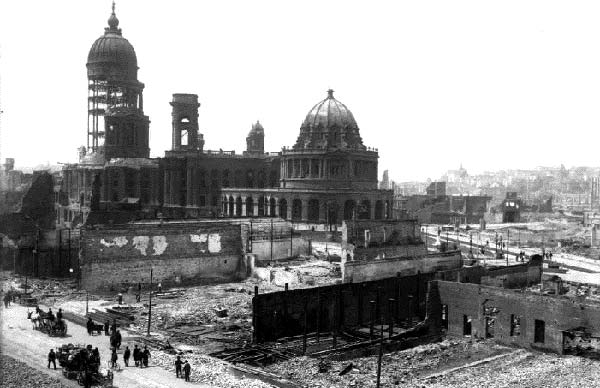
San Francisco City Hall and the Hall of Records dome to the right
after the earthquake - 1906
Photo courtesy The Virtual Museum of the City of San Francisco
Among the structures that were casualties of the San Francisco
earthquake in April of 1906, probably more so the devastating fires that
followed it, were Mechanic's Pavilion and the City Hall. Built in 1882
and 1897 respectively on land that until 1850 had been occupied by the
former Yerba Buena Cemetery, the Pavilion was the largest building in
San Francisco and its' first major indoor arena. It stood where several
years later the Civic Auditorium, at 99 Grove St., would be built.1&2
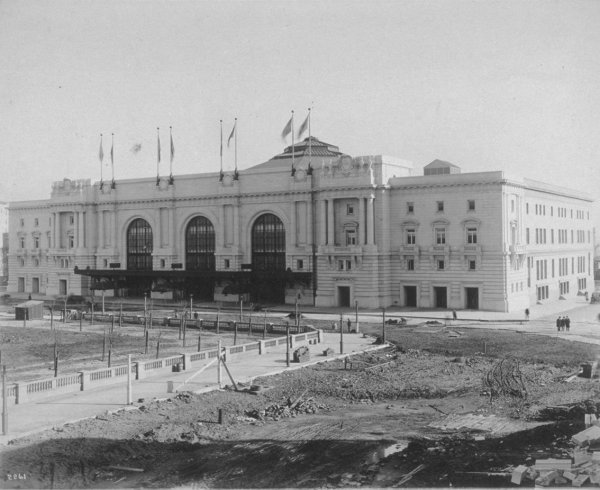
San Francisco's Exposition Auditorium - ca. 1914
Photo courtesy
Friends of the BGCA

San Francisco's Exposition Auditorium - 1915
Photo courtesy Live
Auctioneers
Begun in 1913 and designed by architects John Galen Howard, Frederick H.
Meyer and John Reid, Jr. for the 1915 Panama-Pacific International
Exposition, the 314,179 square-foot Civic (Exposition) Auditorium was
one of several buildings, including the similarly styled (called Beaux
Arts) City Hall that comprise Civic Center.3
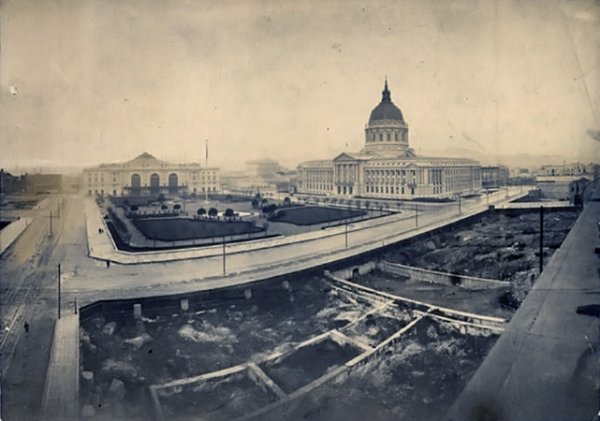
Sam Francisco's Civic Center with Civic Auditorium and
New City Hall
Photo courtesy Jerry's
Brokendown Palaces
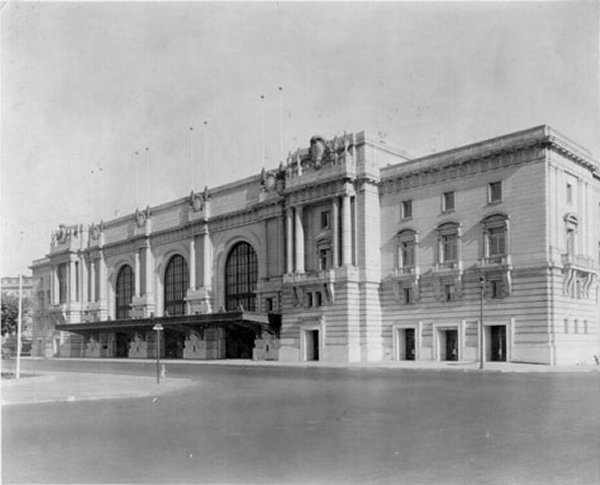
San Francisco's Civic Auditorium
Photo courtesy San Francisco Public Library
The city had purchased the $701,437.08 site but the four
story tall auditorium was financed by the exposition management for
$1,000,000.00 and gifted to the city after the event.3 The other
buildings include the War Memorial Opera House, the War Memorial
Veterans Building, the Main Library and the State and Old Federal
Buildings built in the 1920s and 1930s.2

Meehan-Fulton fight at Civic Auditorium for the benefit of United War
Workers - Nov. 16, 1918
Photo © by G.W. Blum courtesy The Virtual Museum of the City of San Francisco

1920 Democratic National Convention - June 28, 1920
Photo
© Corbis
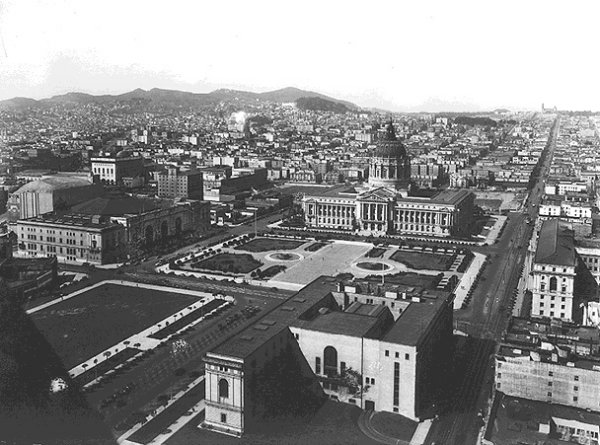
New City Hall with the Civic Auditorium at left and Main Library lower
right - ca.1930
Photo: Greg Gaar Collection, San Francisco, CA
courtesy FoundSF
The Auditorium contains what at the time was the world's
seventh largest pipe organ, moved to the main arena at the end of the
Exposition. In the years that followed the auditorium became a cultural
focal point in San Francisco and in 1920 hosted the Democratic National
Convention. It was also home to San Francisco's Symphony Orchestra prior
to completion the War Memorial and Performing Arts Center which
strengthened its status as a music and performing arts venue.3
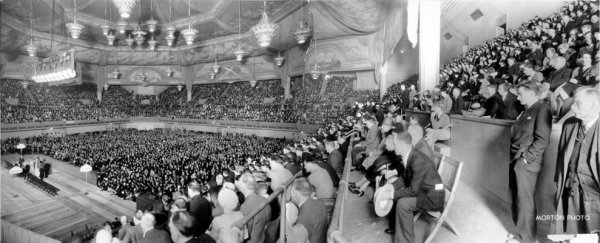
Broadcast of the opera "Lucia" with opera star Lily Pons
at the San Francisco Civic Auditorium - Oct. 23,1932
Photo © San Francisco History Center, San
Francisco Public Library
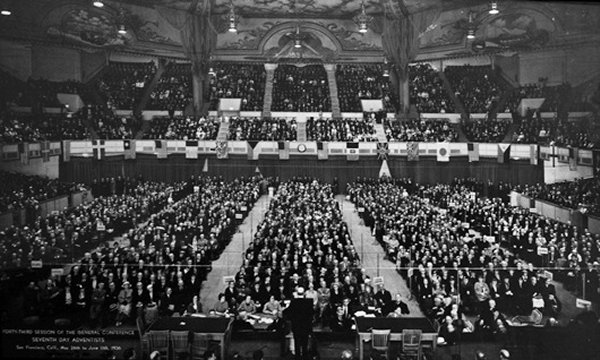
General Conference Session of Seventh Day Adventists meet at the Exposition Auditorium - 1936
Photo courtesy Seventh
Day Adventist Church
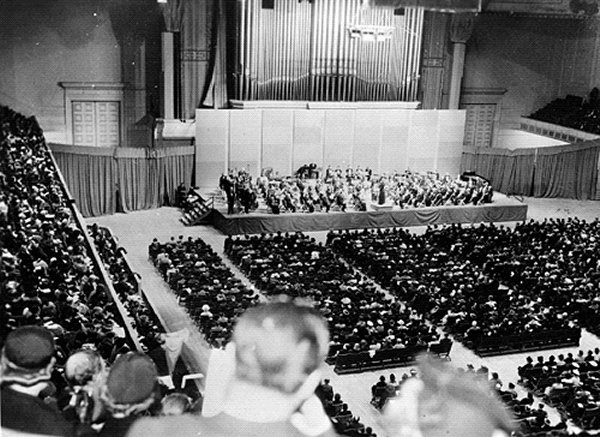
Dr. Antonia Brico conducting the Bay Region Symphony
Orchestra - Aug. 1938
Photo courtesy
New
Deal Network

Unidentified event at the San Francisco Civic Auditorium
Photo © San Francisco History Center, San
Francisco Public Library
On October 26, 1957 a little over a week after
Jailhouse Rock made its premier in Memphis, Elvis, Scotty, Bill
and DJ began what would be their last tour together with two shows at
the Civic Center. Scotty and Bill had previously
resigned their positions early in
September. In the interim Elvis had made one appearance without them,
in Tupelo, and they had played a two-week
gig at the Texas State Fair in Dallas.
|

SF Chronicle ad - Oct. 24, 1957
courtesy SFPL |
|

courtesy E. Lorentzen |
|

Scotty's contract for the October West Coast shows - Oct. 17, 1957
Photo © James V. Roy |
According to Scotty in his book, when they returned from
Texas they received a telephone call from Tom Diskin, Colonel Parker's
assistant. Elvis had four concerts scheduled for San Francisco[,
Oakland] and Los
Angeles for October 26 through October 29. Diskin told Scotty that if
they rejoined the group, Elvis would pay them $1,000 each, or $250 per
show. Scotty and Bill agreed to rejoin the band on those terms, with
the understanding that any future bookings would be on a per—diem
basis. "Just send us some contracts," says Scotty, getting some
satisfaction from knowing how the phone call must have made Parker
cringe. Later, they learned the phone call had been made at Elvis's
insistence.4
|

Letter with contracts to Scotty from Tom Diskin - Oct. 17, 1957
Photo © James V. Roy |
On October 17, the day after they
returned from Texas, Diskin sent the contracts. In his letter, Diskin
asked Scotty to send the contracts special delivery to the Sahara
Hotel in Las Vegas. The letter, which was formal and to the point,
said Scotty and Bill could travel from Memphis to California with D.
J. in Elvis's limousine at no extra charge, but then added—with a
characteristic Parker jab—“Should you decide to travel by some other
method that would be of course at your own expense.”4
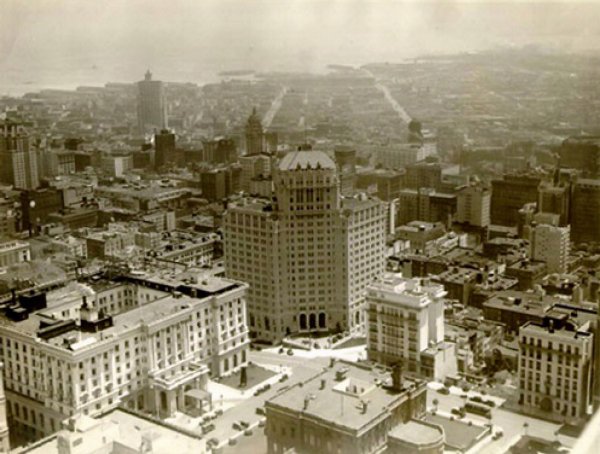
The Mark Hopkins Hotel (center) at One Nob Hill in San
Francisco - ca. 1926
Photo courtesy InterContinental Mark Hopkins San Francisco
As Diskin mentioned in his letter, Elvis and entourage stayed at the
Mark Hopkins Hotel for their stay in the Bay area and according to Alan Hanson,
Elvis arrived in San
Francisco by train only hours before the first show at the Civic Center and checked into
his five room suite in the prestigious Hotel. He wrote
that a columnist referred
to his accommodations as the "Presleydential suite."
5 A combination of French château and Spanish
ornamentation the 19-story Mark Hopkins Hotel was completed in 1926,
named for one of the founders of the Central Pacific Railroad and
built on the site of his former mansion. In 1893 the mansion and
grounds had been donated to the San Francisco Art Association by
Hopkins' widow's second husband, Edward Francis Searles of Methuen,
Massachusetts, after her death. It too was destroyed in the fires that ensued after
the 1906 Earthquake and the site was later purchased by mining
engineer and hotel investor George D. Smith who began construction of
the luxury Hotel. The 19th floor penthouse suite was converted
in 1939 into the glass-walled Top of the Mark restaurant cocktail
lounge, a popular spot for Pacific-bound servicemen during WWII.6
|

Examiner ad - Oct. 25, 1957
courtesy SFPL |
|

Chronicle Ad - Oct. 25, 1957
courtesy SFPL |
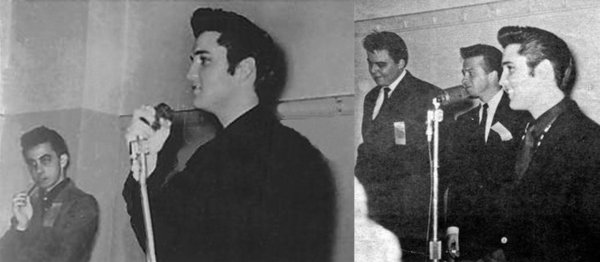
George Klein, Lamar Fike and Cliff Gleaves backstage with
Elvis - Oct. 26, 1957
Photos courtesy ebay and David English
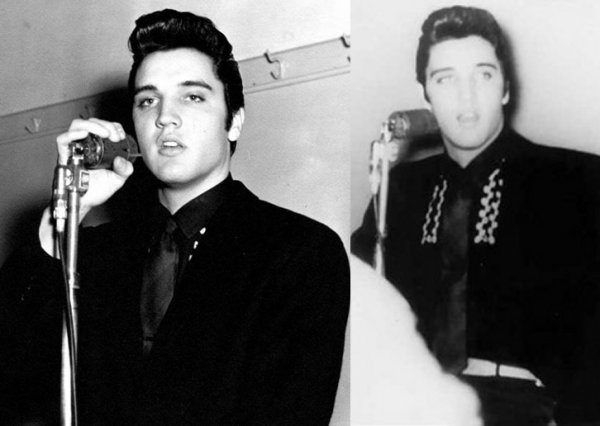
backstage with
Elvis - Oct. 26, 1957
Photo courtesy David English
Scotty and Bill took the limo. The drive took a day and a half. They
met Elvis at the San Francisco Civic Auditorium and he acted as if
nothing had happened. “Nothing was said that I can remember,” says
Scotty. “We laughed and went on and did the show like we used to do.
There weren’t any hard feelings visible with anyone. We didn’t go there
with a chip on our shoulder. I don't think it was even brought up."
4
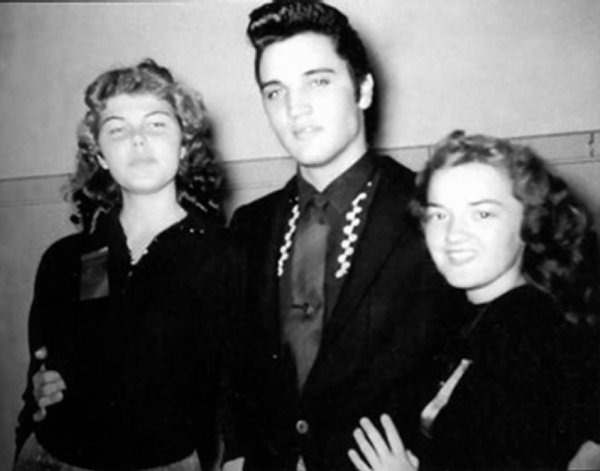
Fan club members backstage with
Elvis before 1st show at the San Francisco Civic Auditorium - Oct. 26, 1957
Photo courtesy David English
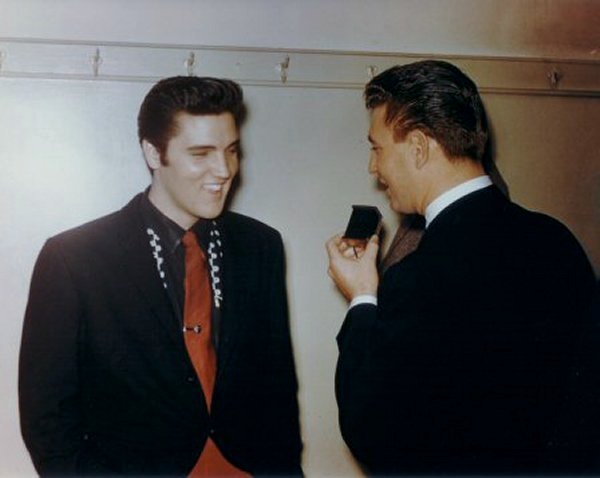
Elvis interviewed backstage before the 1st show at the
San Francisco Civic Auditorium- Oct. 26, 1957
Photos courtesy
Brian
Petersen
Each show was preceded by a press conference backstage and the San
Francisco Chronicle and Examiner reviewed the shows with the
Examiner's seeming more favorable. The Chronicle basically
reviewed the press conference:
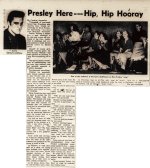 Presley
Here --- Hip, Hip Hooray Presley
Here --- Hip, Hip Hooray
|

Part of the audience at the Civic Auditorium as Elvis
Presley "sang" |
By Carolyn Anspacher
Thousands of pre-conditioned San Francisco adolescents were "shook up" yesterday by Elvis
Presley, the hip-waving vocalist from Memphis Tennessee.
Presley, wearing a pompadour, a pout, sideburns to his chin and a wine red
suit, played at the Civic Auditorium to afternoon and evening audiences whose shrieks carried down to Market Street.
Claques of young girls, proudly wearing green ribbons marked "Official", had been coached all morning to "give Elvis everything you've got".
They gave screams, swoons, tears so wholeheartedly that not even they
realized what was painfully apparent to Presley's managers.
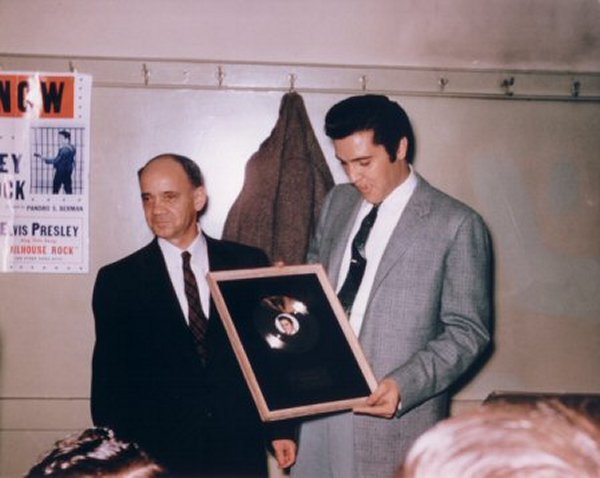
backstage with Elvis before the 2nd show at the Civic
Auditorium - Oct. 26, 1957
Photo courtesy
Brian
Petersen The afternoon was skimpy.
Whether the preponderantly female audience came to hear Presley sing or to watch his caricature of sex could not be determined. They roared through everyone of his 14 rock and roll offerings in such crescendo that three policemen and four firemen were forced to leave the building.

Fans with Ken Moore and Elvis
before the 2nd show at the Civic Auditorium - Oct. 26, 1957
Photo courtesy David English Thirty Pinkerton cops were on hand to protect the 22-year-old Presley from his public. The platoon was augmented by squads of strong arm men who shouted repeatedly that the audience would not be permitted near the 28-foot stage.
Presley did not appear before his palpitating admirers until the second half of a mediocre variety show.
For half an hour he held count in a dressing room surrounded by the winners of a "Why I like Elvis Presley" contest, officers of a "The King's Klan" and "The Sideburn Set"; several disc jockeys and a few apathetic reporters.

Fans with Ken Moore and Elvis
before the 2nd show at the Civic Auditorium - Oct. 26, 1957
Photo courtesy David English Pasty faced and nervous, he wiped his sweating hands over the front of his tight
trousers and grimaced at the group in front of him.
In response to what they took for a
smile, the young girls huddled close together. One burst into tears. Seven snapped pictures of
him. Three sketched him. Then they began raising their hands, as if they were in
class, asking recognition.
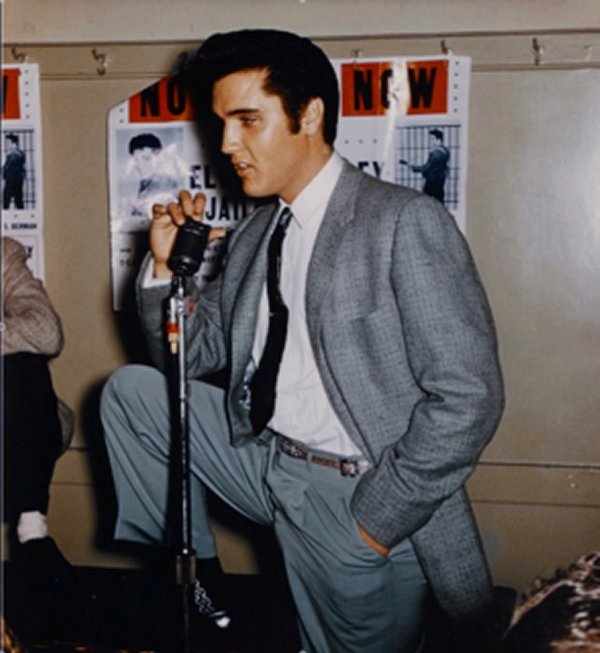
Elvis backstage before the 2nd show at the Civic
Auditorium - Oct. 26, 1957
Photo courtesy David English In his husky drawl, Presley said he didn't know when he was going in the Army. He was 1-A, he said, and waiting to be called.
No, he said, he didn't wear a wig.
No, he never did say he didn't need the press anymore.
"Who are you mad about
now?" one girl asked.
Presley twitched slightly."
No one in particular," he
said.
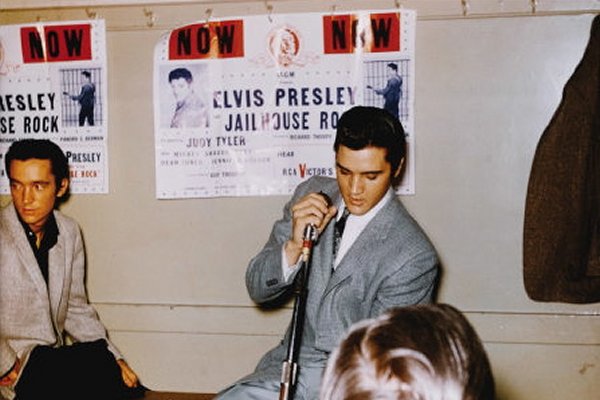
Gene Smith and Elvis backstage before the 2nd show at the
Civic Auditorium - Oct. 26, 1957
Photo courtesy David English "What's your ultimate ambition?", another girl asked.
"My ultimate
ambition," he said," is to become an actor. I couldn't handle anything real heavy now. I'll have to work up to
it."
"Are you studying drama?", he was asked.
Presley twitched again.
"I'm not studying
anything", he said. "I figure it's experience that counts, not studying. I never had any lessons I just take things as they come and when this comes
up I'll make the best of it."
Then came an interlude of photographing. After that Presley autographed everything handed to him
-- shoes,
programs, handkerchiefs, scarfs, bits of paper. They all read:
"Loving You", Elvis."
He called all his young admirers "Honey" and absently rubbed their shoulders and
necks.
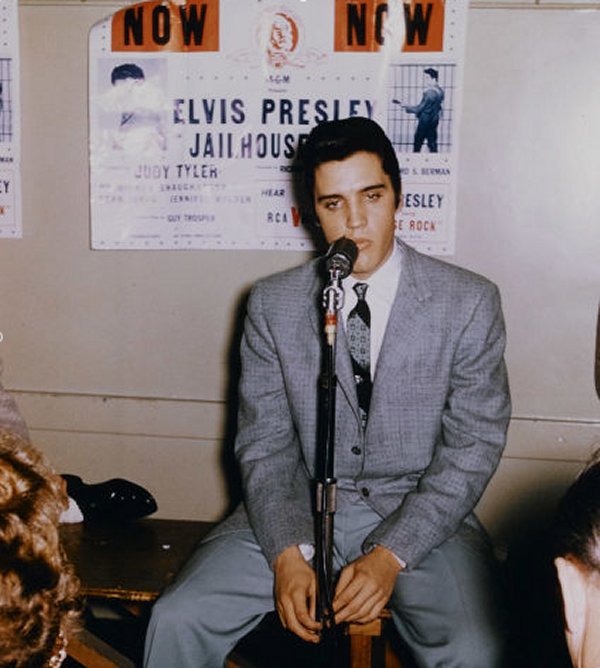 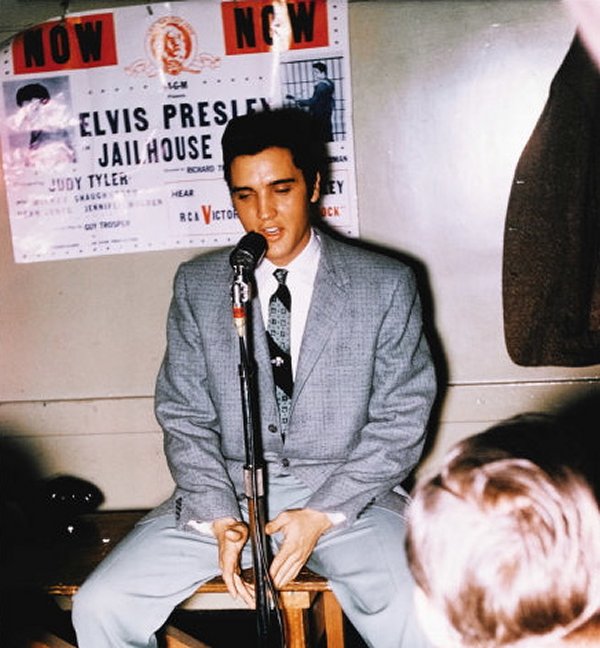
Elvis backstage before the 2nd show at the Civic
Auditorium- Oct. 26, 1957
Photos courtesy David English Three minutes before he burst on stage he confided one chilling note:
At Christmas time an album of seasonal
songs, sung by Presley, will be released. The only song he hasn't monkeyed with, he
said, is "Silent Night."
"It'll be a rock and roll Christmas", he said.
The
girls screamed.
San Francisco Chronicle October 27, 1957 courtesy San
Francisco Public Library
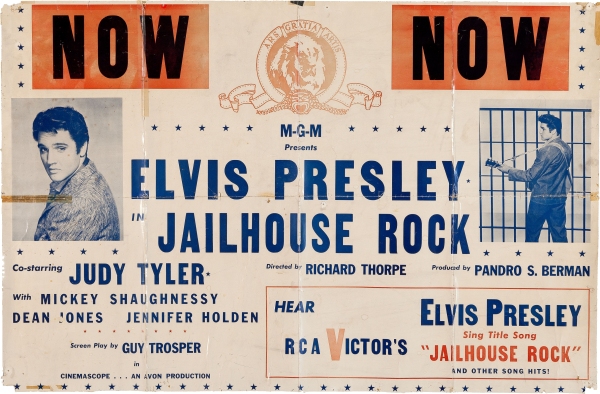
a Jailhouse Rock poster like the ones hung backstage at the San
Francisco Civic Auditorium
Photo courtesy Heritage Auctions

Elvis and Howard F. Hardin backstage before the 2nd show
at the Civic Auditorium - Oct. 26, 1957
Photo courtesy David English
On this tour one of the opening acts was Howard F. Hardin, a variety
artist, comedian, juggler and emcee. A World War II veteran, in addition
to Elvis, he had also opened for Sammy Davis Jr.7
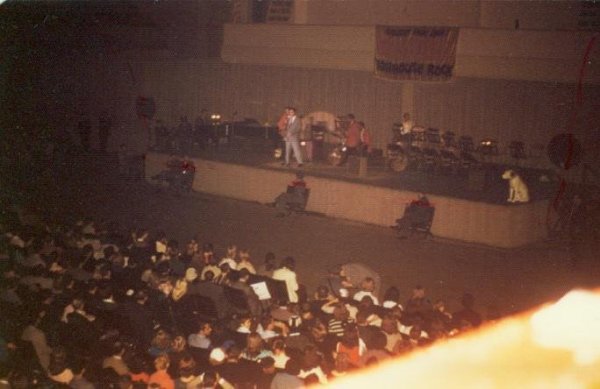
The 2nd show at the Civic Auditorium - Oct. 26, 1957
Photo courtesy FECC/thefool via Arrested
Decay Music
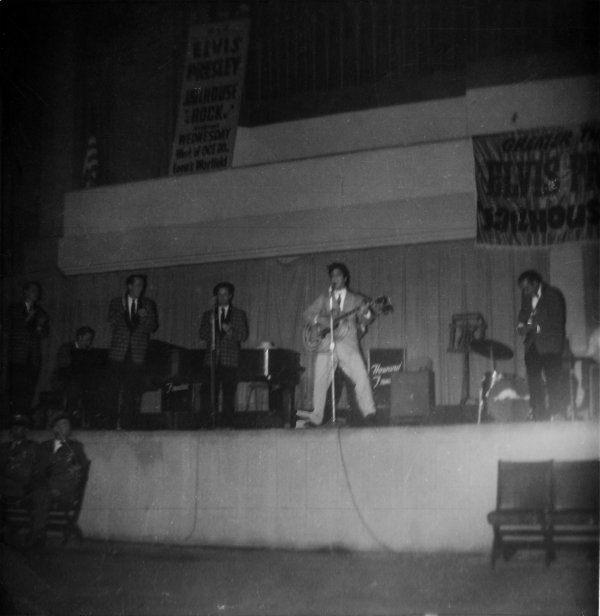
The 2nd show at the Civic Auditorium - Oct. 26, 1957
Photo © Erik
Lorentzen
The Examiner's review was as follows:
 Day and Night
by Dwight Newton
All Shook Up . . .
As any teen-ager will tell you, there's a thing going
around called the "Asiatic Flu" played by Ebe Sneezer and His Epidemics.
I've not only heard it, I've HAD it.
|
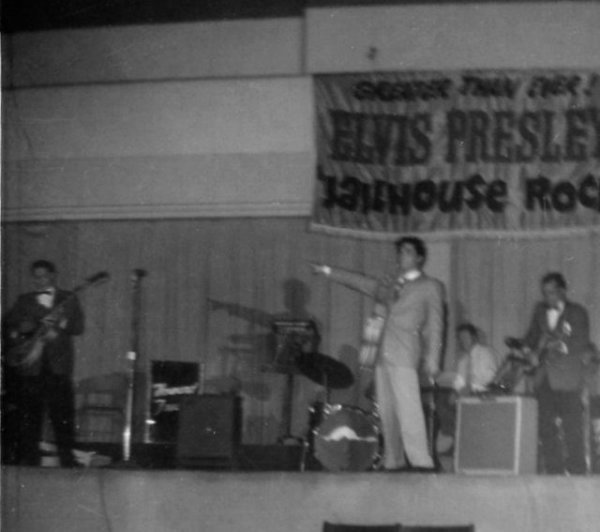
Elvis introduces Scotty during the 2nd show at
the Civic Auditorium - Oct. 26, 1957
Photo © Erik
Lorentzen |
For three days, last week, I thought I would die at my typewriter --
sniffles, fever, headaches, body pains, the works.
And then, suddenly, I recovered. I took the shock treatment.
Saturday afternoon I went to see Elvis Presley.
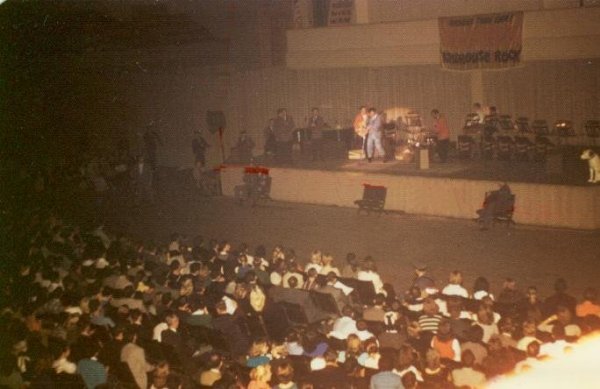
The 2nd show at the Civic Auditorium - Oct. 26, 1957
Photo courtesy FECC/thefool via Arrested
Decay Music
All I knew about Elvis is what I had viewed three times on television
and what I tune out 24 times every night on radio.
Today's mothers squealed at Frank Sinatra; their daughters shriek at
Elvis. Only seeing is believing.

The 2nd show at the Civic Auditorium - Oct. 26, 1957
Photo © Erik
Lorentzen
The Civic Auditorium was half filled. The house seemed hostile. A boy
grumbled, "Ninety-two per cent of the people here are females." He was
right.
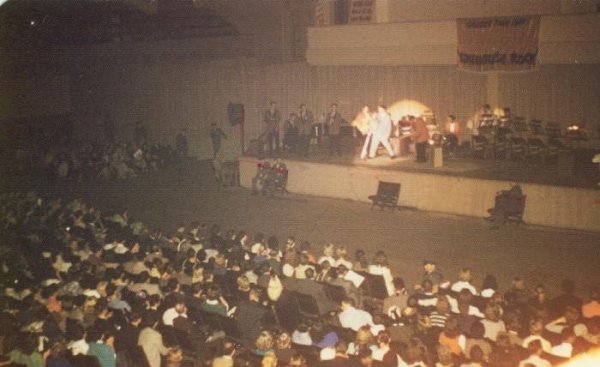
The 2nd show at the Civic Auditorium - Oct. 26, 1957
Photo courtesy FECC/thefool via Arrested
Decay Music
The show opened with Howard Fredric's brassy orchestra. "The band will
kill him if nothing else does," smirked a boy next to me. A singer
named Paula Page received mild applause as another boy shouted: "Hooray:
it's over with!" Local Paul Desmond warmed them with song and patter,
the singing Jordanaires upped the temperature.

The 2nd show at the Civic Auditorium - Oct. 26, 1957
Photo © Erik
Lorentzen
Then came Elvis!
All I remember is thunder and lightning. The thunder of shrieking
kids, the lightning of a thousand flash bulbs as they took pictures.
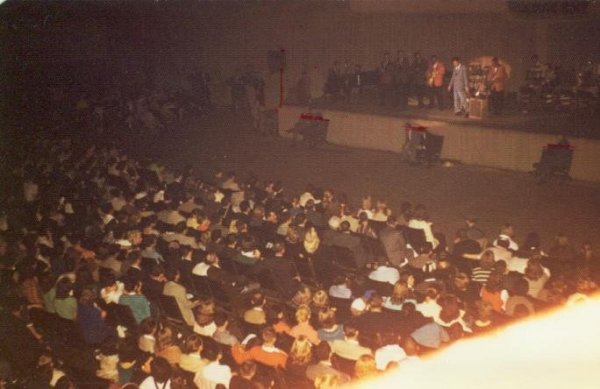
The 2nd show at the Civic Auditorium - Oct. 26, 1957
Photo courtesy FECC/thefool via Arrested
Decay Music
For 70 sustained minutes I never heard a word Elvis said or sang.
Because of the shrieking. It was Lindberg from Paris, VJ Day on Market
St., voodoo night in Haiti. It was pandemonium.
Elvis grunted, groaned, growled, shook, jigged, knocked his knees
and rattled his bones. He didn't coast on his fame. He gave the kids all
he had. He perspired, panted, ranted and raved. Girls jumped from their
seats like schools of salmon rising to the bait. They waved both arms.
They shrieked, continuously.
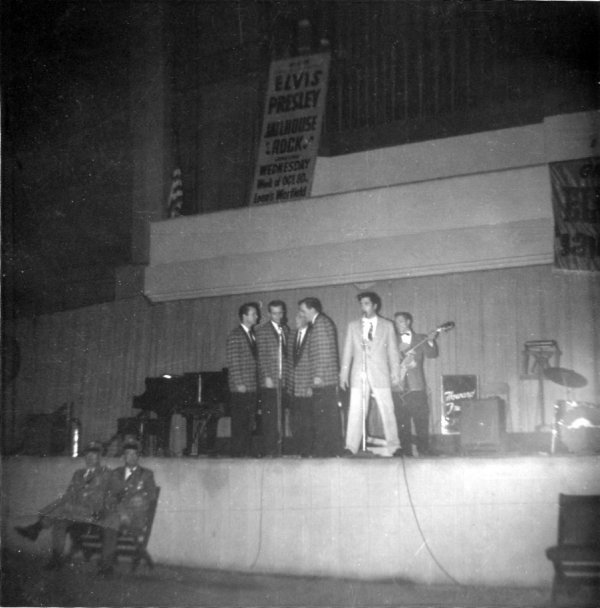
The 2nd show at the Civic Auditorium - Oct. 26, 1957
Photo © Erik
Lorentzen
When Elvis feigned passion, the kids gasped and sighed as they
shrieked. When he laughed at his own crazy antics, they laughed and
hooted as they shrieked.
Actually, it wasn't Presley's show at all. It was the teen-ager's
show, their day to howl and have fabulous fun. Elvis was just the
excuse.
When exhaustion should have set in, Elvis closed the show with his
national anthem, "Hound Dog." That was the pay off. That was when the
roof fell in. That was when I lost my Asiatic flu. That was the shock
treatment.
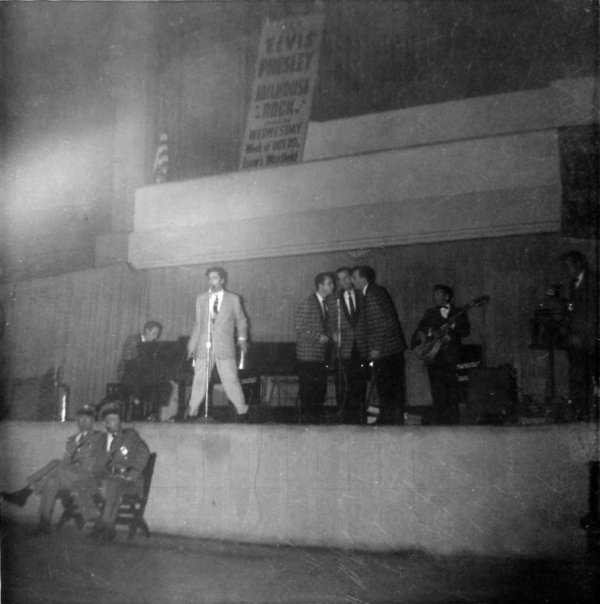
The 2nd show at the Civic Auditorium - Oct. 26, 1957
Photo © Erik
Lorentzen
Do I disapprove? Of course not! For the kids who saw him it was a day
they'll never forget, a day to tell their grandchildren about as I've
already told mine.
I've seen many spectacular performers--Buffalo Bill, Caruso, Souza,
Billy Sunday, Jolson, Schumann-Heink, the Marx Brothers, Kirsten
Flagstad, Aimee Semple McPherson, Crosby, Sinatra, Lena Horne,
Liberace--but I've never witnessed a storm of excitement like the one
generated by Elvis Presley.
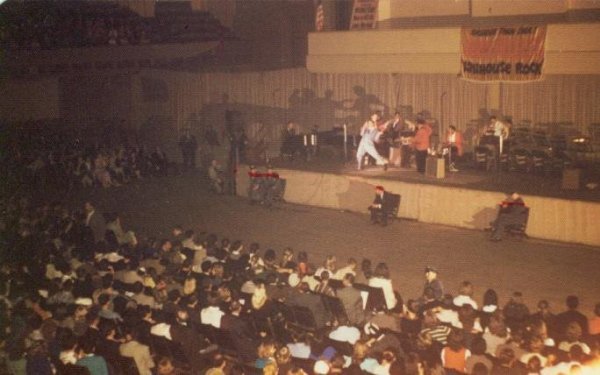
The 2nd show at the Civic Auditorium - Oct. 26, 1957
Photo courtesy FECC/thefool via Arrested
Decay Music
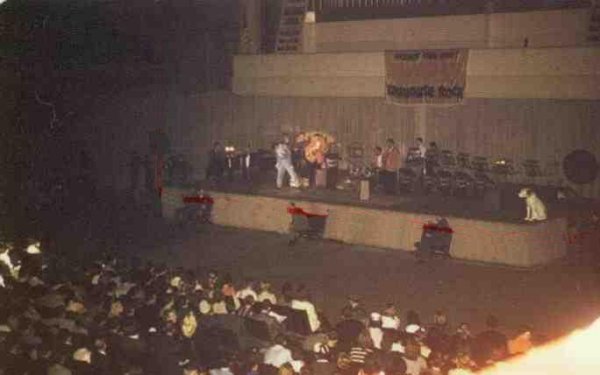
The 2nd show at the Civic Auditorium - Oct. 26, 1957
Photo courtesy FECC/thefool via Arrested
Decay Music
May he endure and mature with the kids who idolize him. Bing and
Frank are betting on him. So am I.
October 29, 1957 San Francisco Examiner
courtesy San Francisco Public Library
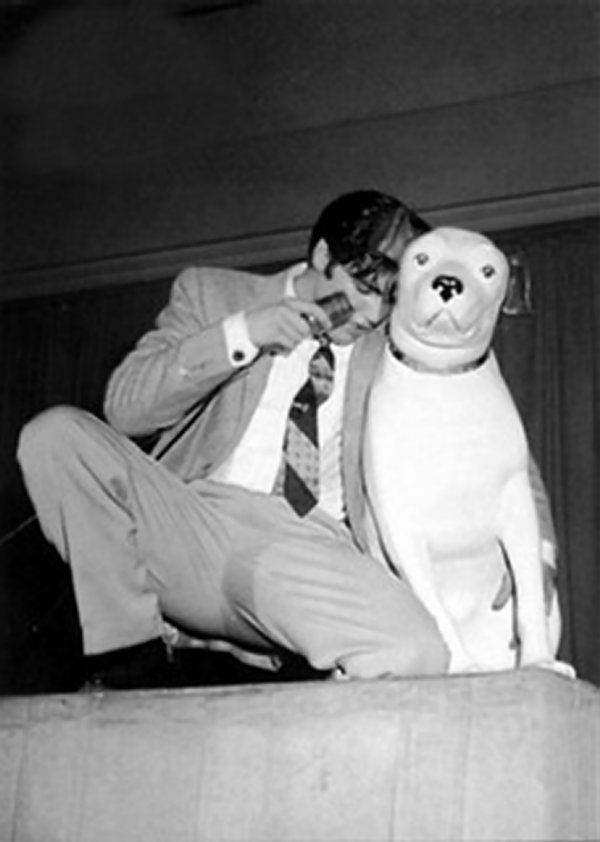
Elvis and Nipper during the 2nd show at the Civic
Auditorium - Oct. 26, 1957
Photo courtesy David English
The following day, on the 27th, they played across the bay in Oakland
and completed the tour with two nights in LA. On November 8th,
Jailhouse Rock opened wide across the country and at the Warfield
Theatre on Market St. in San Francisco. The Examiner's drama
critic pretty much panned it though praised Elvis' performance, in spite
of mis-crediting Mickey Shaughnessy's role in From Here to Eternity.
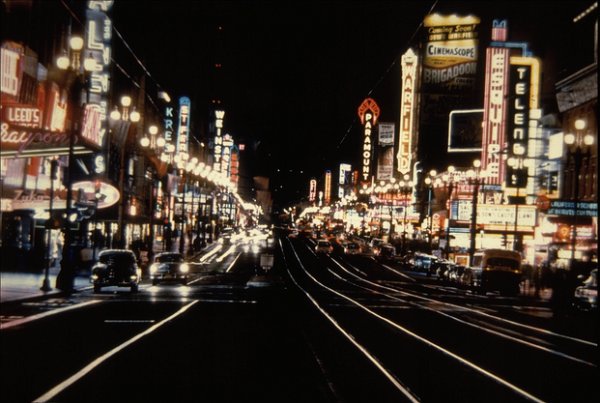
Loew's Warfield Theater on right along theater row on
Market St. in San Francisco - ca. 1953
 'Jailhouse Rock', With Presley, at Warfield 'Jailhouse Rock', With Presley, at Warfield
By HORTENSE MORTON
Examiner Drama Critic
ELVIS PRESLEY, toothy singer-guitarist. who acts as it he is about to
become unglued. is making his second San Francisco appearance, within a
week, now on the
screen of Loew's Warfield in "Jailhouse Rock."
The squealers are still around...just as they were in the days of
Francis X. Bushman, Rudolph Valentino, Frank Sinatra and Liberace, whose
fans burbled over their double chins. I don't doubt that babes flipped
their tippets over David Garrick, E. H. Sothern and Henry Irving when he
was hearing the darn bells.
It's a form of juvenile exhibitionism. If the future mothers of America
insist on flexing their vocal chords --so what? This too shall pass
until the next Adonis, as viewed by adolescent standards, arrives on the
horizon.
As of this minute, I'm glad l don‘! have to eat crow or retract mean
words. Presley and his flapper (hey, where did that word come from?)
following are standard equipment. l liked the kid. He gives a better
account of himself than did the scriptwriter.
Both Crosby and Sinatra came up from the clef ranks to register as
actors. Presley might do likewise. He's quite clever as a kid, too fast
of temper, who winds up in prison (wonder how his devotees like this
touch) on a manslaughter conviction.
His cell-mate, Mickey Shaughnessy, old theatrical trouper, teaches him
the nuances of the guitar.
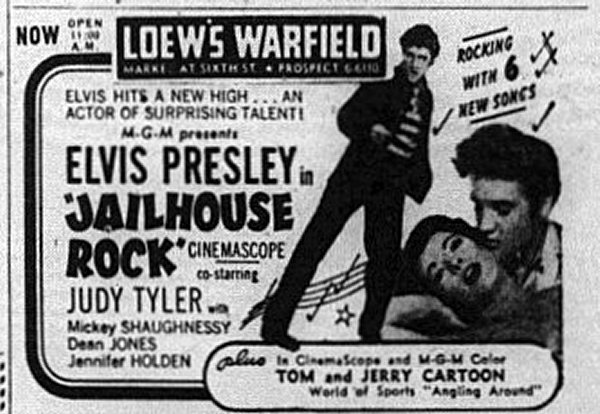
When Presley is released, earlier than his mentor, he meets a publicity
gal, (Judy Tyler the youngster killed in an automobile accident last
summer), who suspects his talent and goes all out to exploit him via
disc jockey route. etc.
He‘s a hit on TV and eventually in Hollywood. When his pen pal
Shaughnessy shows up, there's a mishmash over contracts and Presley's
highhanded attitude. Shaughnessy slugs the singer, messes his larynx,
and total eclipse of a successful career is intimated.
As I said. It‘s a stupid plot. The little guy who becomes a national
hero and a fat headed slob.
But performances are rather good. Shaughnessy, you will recall as the
sadistic sergeant in "From Here to Eternity."
Frankly, I think Presley will turn into quite an actor. It isn't going
to happen tomorrow or neat year. But, it will happen. And, the next
studio he signs with should spend a little dough on dental work. This is
being personal--but unless he wants to go in for character roles, a D.D.S. is indicated. Right now. he looks like a fugitive from a Disney
feature.
San Francisco Examiner October 31, 1957 courtesy San
Francisco Public Library

Warriors forward Cotton Nash shoots in a game against the
Lakers at the Civic Auditorium. Dec. 3, 1964
Photo by John McBride courtesy
The Chronicle
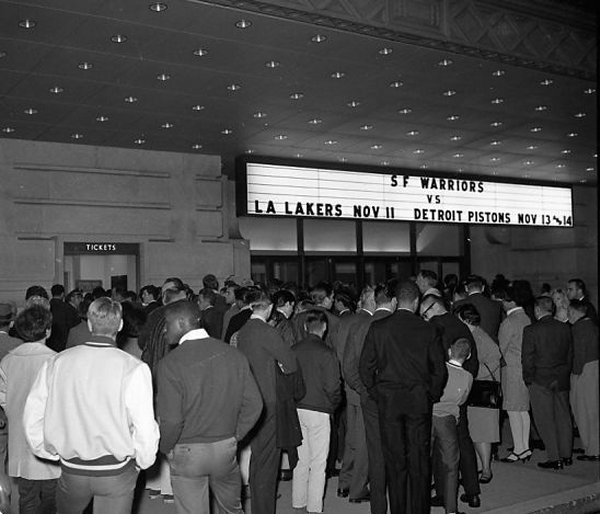
The Civic Auditorium during a Warriors game against the
Lakers. - Nov. 11, 1966
Photo by Art Frisch courtesy
The Chronicle
The auditorium was rehabilitated and modernized in the 1960s, and after
the NBA's Philadelphia Warriors moved to San Francisco in 1962, it
became their home as the San Francisco Warriors until 1966.2 The team
moved to the Oracle Arena in Oakland and in 1971 became the Golden State
Warriors.

an empty Bill Graham Civic Auditorium
Photo courtesy
Friends of the BGCA
The pipe organ was removed from the Civic Auditorium for repairs in 1989
after it sustained major damage from the Loma-Prieta earthquake which
caused the back inner wall to crash down. Identified as a seismic risk,
the auditorium became the first major project of the Earthquake Safety
Program Phase 2 (ESP2). Remaining functional as a as a mid-size
performing arts venue, it was renamed for the Bay area promoter Bill
Graham.3 The organ was put in storage in Brooks Hall beneath Civic Center
Plaza after the repairs in Hartford, CT were complete where it remained.9
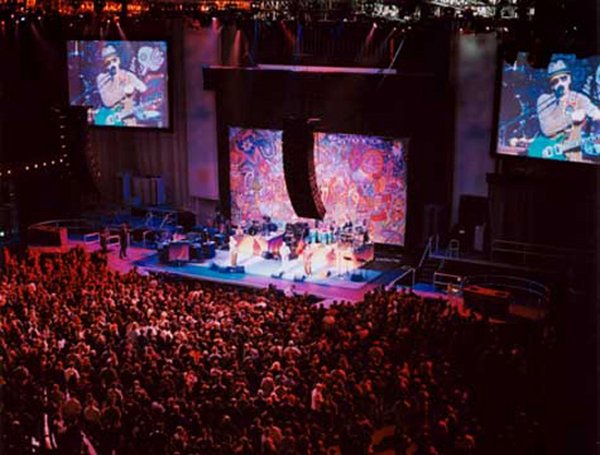
concert at Bill Graham Civic Auditorium
Photo courtesy Uplup
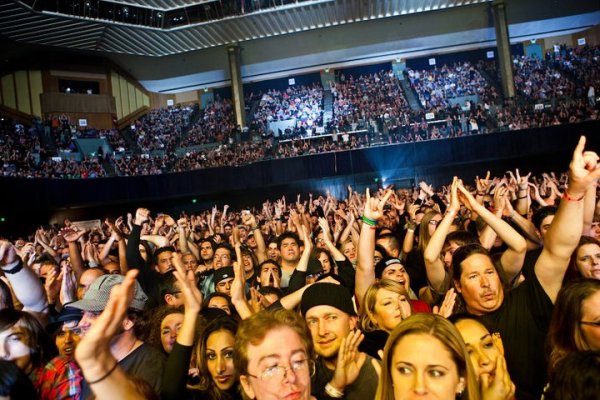
the crowd for a concert at Bill Graham Civic Auditorium
Photo courtesy
Bill
Graham Civic Auditorium
The auditorium closed in 1994 for upgrades which involved a fixed base
concrete shear wall scheme and architectural, mechanical, electrical,
plumbing and hazardous materials abatement work. After a cost of $25.8
Million, the Bill Graham Civic Auditorium reopened in March of 1996
after 20 months of construction as a seismically safe structure with
wheelchair access to all seating categories, upgraded banquet halls,
meeting rooms and restroom facilities.10
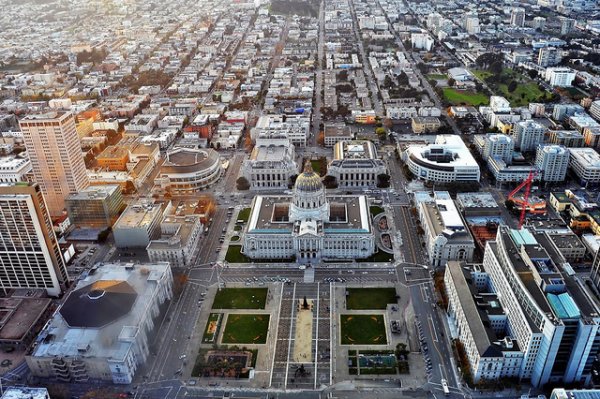
The Civic Center - Nov. 26, 2010
Photo courtesy
C. Roy Yokingco
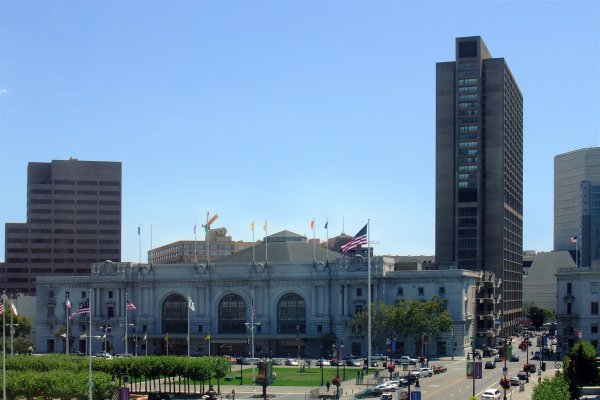
Bill Graham Civic Auditorium, with Fox Plaza in the back
- Aug. 15, 2008
Photo by
J. Ash Bowie
Still a major entertainment spot, as of 2010, the auditorium operates
under the direction of BGCA Management, LLC. With a capacity for 7,000,
it boasts state-of-the-art
theatrical equipment and a concert-quality sound system and is one of
San Francisco's major convention venues hosting numerous concerts and
public events throughout the year. In addition to the Auditorium the
Civic Center, which was designated a National Historic Landmark in 1987,
now consists of City Hall, the Asian Art Museum, Davies Symphony Hall,
the San Francisco Public Library, War Memorial Opera House and Veterans
Building.2&3
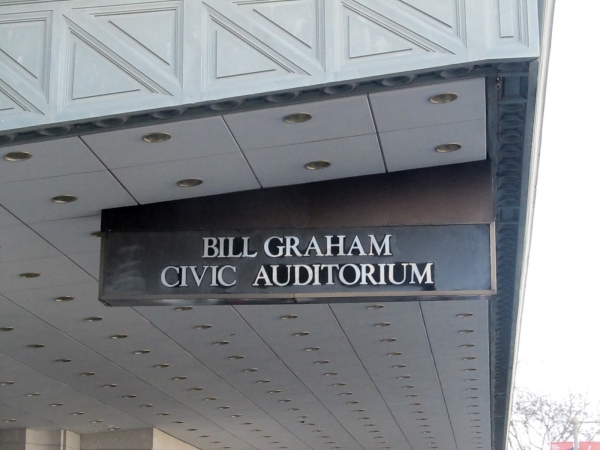
Bill Graham Civic Auditorium
- Jan. 25, 2014
Photo © James V. Roy
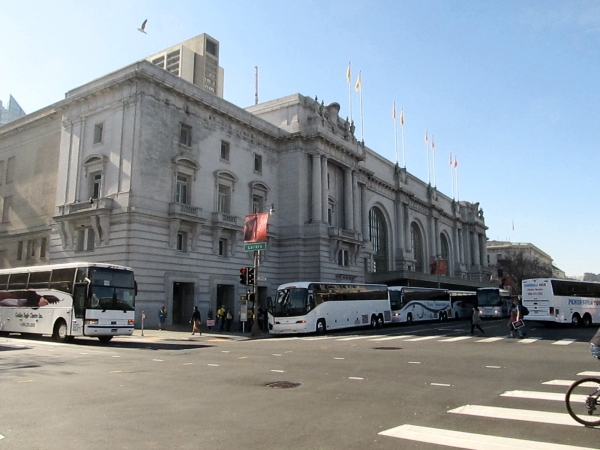
Bill Graham Civic Auditorium
- Jan. 25, 2014
Photo © James V. Roy
page added March 7, 2014
1 according to
Remembering Mechanics Pavilion by Brian Daley -the Examiner, April
20, 2010
2 according to
Civic Center in San Francisco, California, courtesy
inetours
3 according to
Friends of the BGCA:History
4 excerpt from
That's Alright Elvis by Scotty
Moore and Jim Dickerson
5 according to
Elvis '57: The Final Fifties Tours by Alan Hanson
6 according to
Mark Hopkins Hotel by
wikipedia
7 according to
Variety - Howard Hardin - January 19, 2001
8 according to
Golden State Warriors by wikipedia
9 according to
Group wants huge organ moved to Palace of Fine Arts, by Wayne
Freedman -
ABC7NEWS, February 23, 2012
10 according to
City
and County of San Francisco DPW: Bill Graham Civic Auditorium
|
























 Presley
Here --- Hip, Hip Hooray
Presley
Here --- Hip, Hip Hooray
























 'Jailhouse Rock', With Presley, at Warfield
'Jailhouse Rock', With Presley, at Warfield









